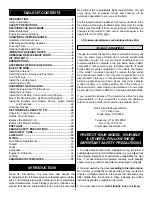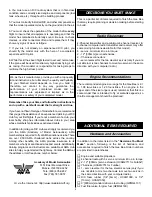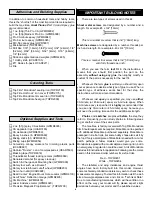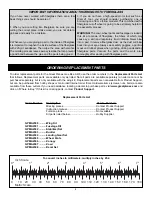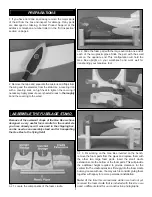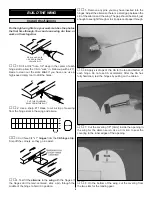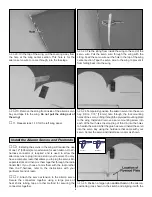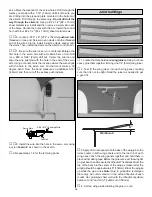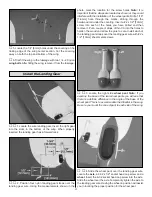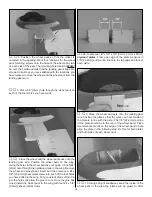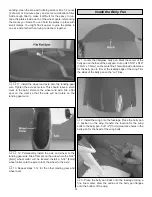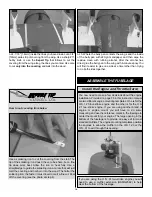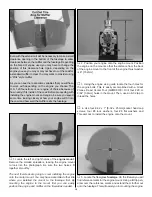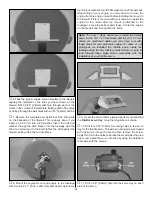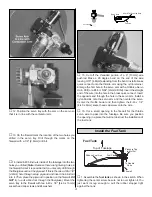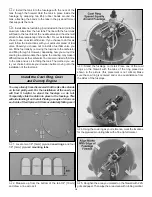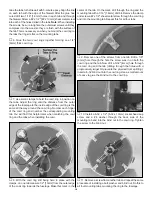
In addition to common household tools and hobby tools,
this is the “short list” of the most important items required to
build the Gee Bee.
Great Planes Pro
™
CA and Epoxy glue
are recommended.
❏
1 oz. [30g] Thin Pro CA (GPMR6002)
❏
1 oz. [30g] Medium Pro CA+ (GPMR6008)
❏
Pro 30-minute epoxy (GPMR6047)
❏
Pro 6-minute epoxy (GPMR6045)
❏
R/C-56 canopy glue (JOZR5007)
❏
Microballoons (TOPR1090)
❏
Drill bits: 1/16" [1.6mm], 5/64" [2mm], 3/32" [2.4mm], 1/8"
[3.2mm], 9/64" [3.6mm], 5/32" [4mm], 3/16" [4.8mm],
1/4" [6.4mm]
❏
Stick-on segmented lead weights (GPMQ4485)
❏
1 Hobby knife (HCAR0105)
❏
#11 blades (5-pack, HCAR0211)
❏
File
❏
Top Flite
®
MonoKote
®
sealing iron (TOPR2100)
❏
Top Flite Hot Sock
™
iron cover (TOPR2175)
❏
Top Flite MonoKote trim seal iron (TOPR2200)
❏
Top Flite MonoKote heat gun (TOPR2000)
❏
2 oz. [57g] spray CA activator (GPMR6035)
❏
CA applicator tips (HCAR3780)
❏
CA debonder (GPMR6039)
❏
Epoxy brushes (6, GPMR8060)
❏
Mixing sticks (50, GPMR8055)
❏
Mixing cups (GPMR8056)
❏
Curved-tip canopy scissors for trimming plastic parts
(HCAR0667)
❏
Hobbico
®
Duster
™
, can of compressed air (HCAR5500)
❏
Masking tape (TOPR8018)
❏
Threadlocker thread locking cement (GPMR6060)
❏
Denatured alcohol (for epoxy clean up)
❏
Switch & Charge Jack Mounting Set (GPMM1000)
❏
Rotary tool such as a Dremel
®
❏
Rotary tool reinforced cut-off wheel (GPMR8200)
❏
Servo horn drill (HCAR0698)
❏
Dead Center
™
Engine Mount Hole Locator (GPMR8130)
❏
AccuThrow
™
Deflection Gauge (GPMR2405)
❏
CG Machine
™
(GPMR2400)
❏
Laser incidence meter (GPMR4020)
❏
Precision Magnetic Prop Balancer
™
(TOPQ5700)
•
There are two types of screws used in this kit:
Sheet metal screws are designated by a number and a
length. For example #6 x 3/4" [19mm]
This is a number six screw that is 3/4" [19mm] long.
Machine screws are designated by a number, threads per
inch and a length. For example 4-40 x 3/4" [19mm]
This is a number four screw that is 3/4" [19mm] long
with forty threads per inch.
•
When you see the term
test fit in the instructions, it
means that you should first position the part on the
assembly without using any glue, then slightly modify or
custom fit the part as necessary for the best fit.
•
Whenever the term
glue is written you should rely upon
your experience to decide what type of glue to use. When a
specific type of adhesive works best for that step, the
instructions will make a recommendation.
•
Whenever just
epoxy is specified you may use either
30-minute (or 45-minute) epoxy
or 6-minute epoxy. When
30-minute epoxy is specified it is highly recommended that
you use only 30-minute (or 45-minute) epoxy, because you
will need the working time and/or the additional strength.
•
Photos and sketches are placed before the step they
refer to. Frequently you can study photos in following steps
to get another view of the same parts.
•
The Gee Bee is factory-covered with Top Flite MonoKote
film. Should repairs ever be required, MonoKote can be patched
with additional MonoKote purchased separately. MonoKote is
packaged in six-foot rolls, but some hobby shops also sell it by
the foot. If only a small piece of MonoKote is needed for a minor
patch, perhaps a fellow modeler would give you some.
MonoKote is applied with a model airplane covering iron, but in
an emergency a regular iron could be used. A roll of MonoKote
includes full instructions for application. Following are the colors
used on this model and order numbers for six foot rolls.
Red – TOPQ0201
White – TOPQ0204
•
The stabilizer and wing incidences and engine thrust
angles have been factory-built into this model. However,
some technically-minded modelers may wish to check these
measurements anyway. To view this information visit the web
site at www.greatplanes.com and click on “Technical Data.”
Due to manufacturing tolerances which will have little or no
effect on the way your model will fly, please expect slight
deviations between your model and the published values.
IMPORTANT BUILDING NOTES
Optional Supplies and Tools
Covering Tools
Adhesives and Building Supplies
4


